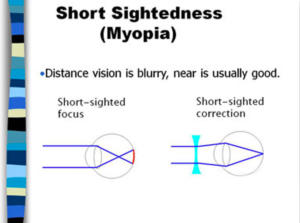BOOK ONLINE NOW
Myopia is perhaps the most common vision disorder, and is usually picked up in childhood or adolescence – perhaps because it seems to progress the most between the ages of eight and 15.
Commonly referred to as ‘short sighted’ or ‘near sighted’, myopia is the medical term given for when a person cannot see distant objects clearly. It is thought that the light entering the eye from a distance is focussed too early, and so the image is blurred.
Children with myopia may have difficulty seeing the board at the front of the classroom, while adults may notice that they are unable to read street signs.
Try out the Myopia Vision Simulator Tool to see how myopia affects a child’s ability to participate at school!
Myopia has traditionally been treated with the wearing of prescription lenses – whether glasses or contacts – to help compensate for distance blur. However, as vision tends to worsen over time, frequent prescription updates are required.

Normal Vision

Myopia
Research into myopia control and treatment has become increasingly important for two main reasons.
Optometry Australia has even described it as a “myopia epidemic” in our children.
While approximately 30% of the worldwide population is currently affected by myopia, this is set to increase to 50% by 2050.
This is because both genetic and environmental / lifestyle factors contribute to the condition, and our ever-increasing reliance on technology and digital devices is largely to blame.
Eye care experts used to think that myopia was benign, however we now know that this is not the case.
People with myopia are much more likely to develop serious eye conditions in the future, such as macular degeneration, retinal detachment, glaucoma and cataracts, all of which could lead to permanent vision loss.
While myopia is a lifelong condition with no cure, research has now revealed that it is possible to slow, halt, or even reverse its progression.

Treatment strategies to control myopia range from simple lifestyle modifications to prescription lenses and more invasive options. For example:
Myopia control is all about giving the individual better vision now, and preventing serious problems down the track.
To find out more about the latest advancements and strategies in myopia management, book an appointment at Aphrodite Livanes Optometrists Eyecare Plus Alexandra Hills – your local myopia control centre in the Redlands.
References:
© 2026 Aphrodite Livanes Optometrist Brisbane: Eye Care Plus. All rights reserved.